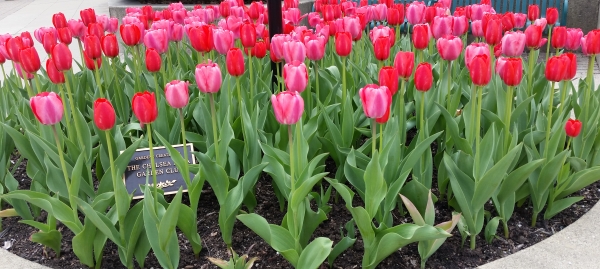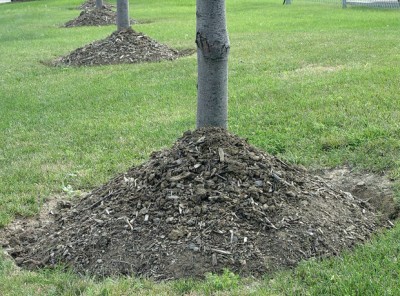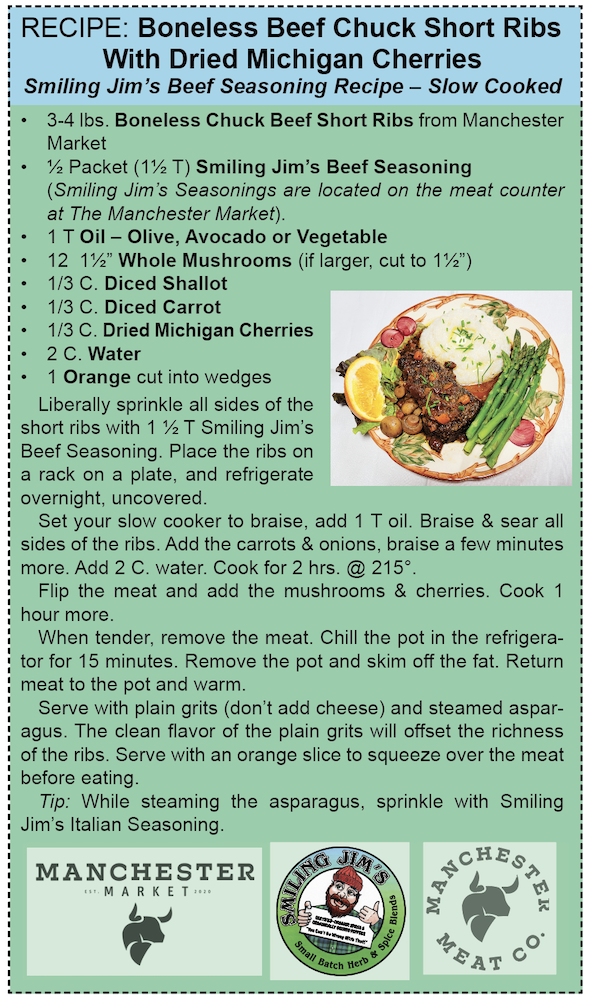May Gardening Advice for Manchester - 2016

by Jennifer Fairfield
Editor's Note: Manchester resident Jennifer Fairfield owns and operates the Garden Mill in Chelsea, serves on the Manchester Community Garden Committee, and volunteers with the school gardens at Klager and the MECC.
Does April snow bring May flowers? It looks like it, from all the tulips popping up all over town! Luckily for us, they were planted in the fall. If they had to be planted in April, they probably wouldn't be coming up yet. The cold snap we suffered through in April made some gardening difficult. Usually, I would have planted a lot more than I did this April, but the weather has just not been cooperating. When it finally does warm up, it’s going to be a mad dash to get some things planted before it’s too late.
May is an interesting month in the world of gardening. It usually starts out somewhat chilly, and is often quite warm by the end of the month. In between, it can go back and forth many times, making it hard to decide what you should be doing in your garden. I hope some of this helps you figure it out.
Vegetables and herbs:
- It’s not too late to plant potatoes and onion sets. Broccoli, cabbage, kale, and head lettuce can also still be planted, as can rhubarb, asparagus, and strawberries. But get all of these in the ground soon, as the first two need a good long growing season, and the rest prefer cooler temperatures. You likely won’t be harvesting the rhubarb, asparagus and strawberries this year, though – in general, they will need a full year to get established before harvesting. Because of this, make sure you have a spot for them where they can grow undisturbed for a number of years. All three like well-drained soil, and really need to be in an area that is kept weed-free in order to thrive. But the work is well worth it!
- Some herbs can be planted now, such as parsley, thyme, sage, and oregano. Others, such as rosemary, basil, cilantro, and dill should wait until all danger of frost has passed. Basil especially should not be planted too early, as it doesn’t tolerate temps below 50° very well.
- Seeds to plant now include leaf lettuce, spinach, carrots, radishes, and beets. Beans can be planted beginning about mid-month or a little earlier, if the soil has warmed up. Seeds planted in soil that is too cold will likely just rot as they wait for the soil temperature that is just right for them.
- If you’re not sure what the right temperature is for your seeds, this chart from Gardener’s Supply is very helpful. A soil thermometer takes the guess work out of getting the timing right.
- If you are starting your own plants, it’s time to start your squash and cucumber seeds indoors, so that they are ready to transplant outside at the end of the month.
Once the soil has warmed up to above 60° and nighttime temperatures are consistently above 50°, it’s safe to plant tomatoes, peppers, eggplant, squash, and cucumbers. Around here, that typically means about the time of Memorial Day weekend.
Flowers:
- Now is a great time to get a jump on weeds, before they get out of control. The good thing about all the rain we got the last few days is that it makes pulling weeds a lot easier! However, I’m going to try a different approach to weeding this year. Take a look at this article from Native Plants and Wildlife Gardens. They are suggesting that for more effective long-term weed control, cutting them back is better than by pulling – for most weeds. So, we’re going to try a little experiment at my house this year to see if that proves to be true.
- Most perennials can be planted any time now – sooner is even a little better than later, as you want them to have a chance to get well-rooted before the hot dry weather sets in. This is also a good time to divide late-spring and summer-blooming plants. Plants that have outgrown their space, or are getting bare spots in the centers should be dug up, divided, and replanted. However, if the plant is in flower now, wait until fall to transplant it.
- For annuals, it’s still a little too early to plant much of anything right now. By about mid-month, it should be OK, depending on the temperatures. Remember, all the annuals available now have been living in heated green houses. Putting them in the ground right now would only shock them, and slow their growth. Like our warm-weather veggies, for these plants as well, it’s better to wait until the soil has warmed up to at least 60° and nighttime temperatures are consistently above 50°. Seeds of annuals should generally be planted once the danger of frost is past.
- Patio pots and hanging baskets can be put out, but you will want to bring them inside at night (an attached garage is fine), if the temps are dipping below about 40°. That shouldn’t be for too much longer, if the long-range forecasts are correct. According to the National Weather Service’s Climate Prediction Center, we should see a warmer than usual May (and summer, apparently) this year.
Trees and Shrubs:
- Now is a good time to plant new trees and shrubs. The Arbor Day Foundation has lots of great tips for choosing the right tree for your needs, along with details for proper planting and care.
- Once your early-blooming shrubs, such as forsythia and quince, have dropped their blossoms, you can prune them back for better growth in the future. Letting them go without regular pruning will cause them to have leaves and flowers on the ends of long, mostly leafless branches. An annual pruning will keep them looking full and give you more blossoms.

mulch volcanos are bad for trees
- Whether you are planting new trees and shrubs or sprucing up existing ones, once the soil has warmed up, it’s time to mulch. Don’t mulch too soon, as that will keep the soil cooler, which can slow down growth. When you are mulching trees, avoid creating mulch “volcanoes” (piling mulch up around the trunk), which can slowly kill your trees. Click here for good tips on mulching from the MSU Extension.
Birds:
- If you haven’t gotten out your hummingbird and oriole feeders yet, don’t delay any longer! They’re here, and they’re hungry from their long trip north.
- Keep your seed feeders full at this time as well. Our birds are busy building nests, laying eggs, and raising baby birds – all hard work that requires lots of nutrition. Yes, there are plenty of insects out there now, but providing easy access to food will get them to stick around your yard, which means lots of entertainment for you.
- It’s also time to put out bird baths, if you haven’t already. Remember to keep them, as well as feeders, cleaned on a regular basis to help prevent disease in your feathered friends.








You must be logged in to post a comment Login